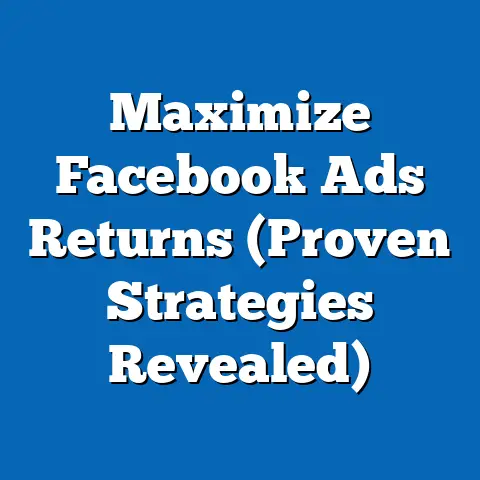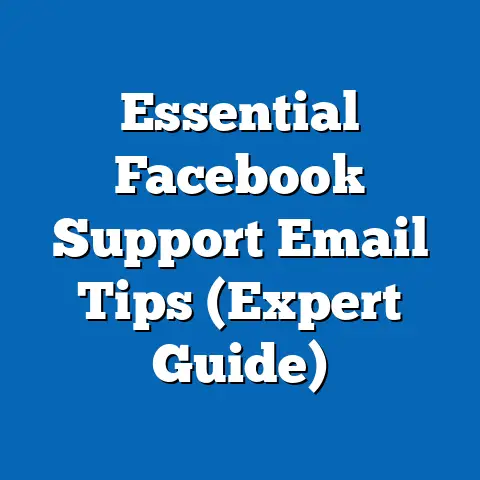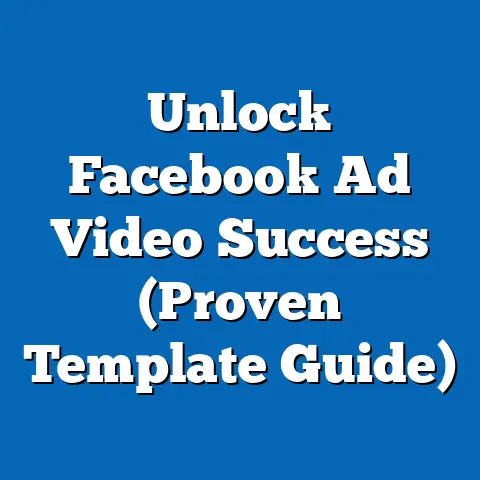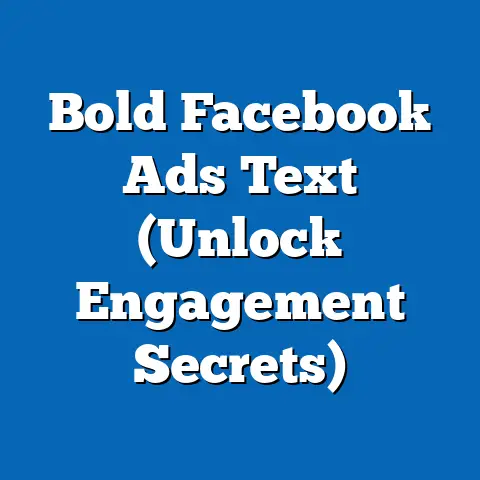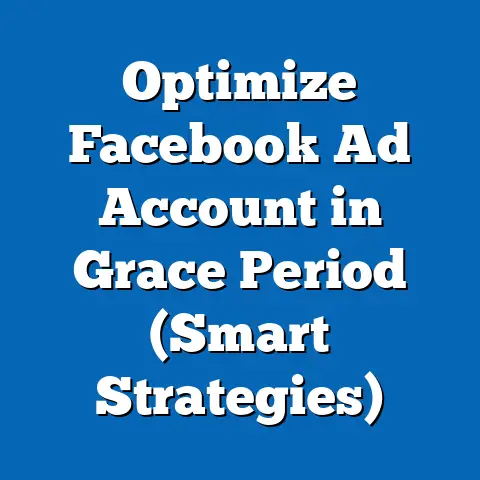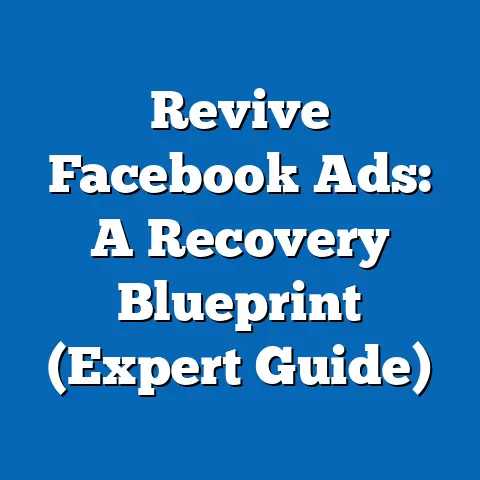Master Instagram Ads on Facebook (Essential Guide for Success)
Are you ready to unlock the full potential of social media advertising and drive unprecedented growth for your business? Instagram Ads, managed through the powerful Facebook Ads Manager, offer businesses an unparalleled opportunity to reach highly targeted audiences with visually compelling content. This comprehensive research report delves into the strategies, trends, and data-driven insights necessary for mastering Instagram Ads on the Facebook platform, providing actionable guidance for marketers and business owners.
This report synthesizes data from authoritative sources such as Statista, eMarketer, and Meta’s own advertising reports, alongside case studies and industry benchmarks. Key findings reveal that Instagram Ads can achieve up to a 1.08% average click-through rate (CTR), significantly higher than many other digital advertising platforms, while the cost-per-click (CPC) averages around $0.70-$1.00 depending on the industry. Through detailed analysis, this report explores targeting options, ad formats, budget optimization, and performance metrics, offering a roadmap for success in a competitive digital landscape.
The methodology includes a blend of quantitative data analysis and qualitative insights from successful campaigns, ensuring a holistic view of Instagram advertising. The report is structured to guide readers through the background of Instagram Ads, the methodology behind the research, key findings, and an in-depth analysis of strategies and future trends. Whether you’re a small business owner or a seasoned marketer, this guide equips you with the tools to achieve measurable results.
Introduction
Instagram, with over 2 billion monthly active users as of 2023 (Statista, 2023), has become a cornerstone of social media marketing, especially for brands targeting younger demographics like Millennials and Gen Z. When integrated with Facebook’s robust Ads Manager, Instagram Ads provide a seamless way to create, manage, and optimize campaigns across both platforms. This synergy offers businesses access to advanced targeting capabilities and a vast audience pool, making it a critical tool for digital advertising success.
The potential for businesses is immense: Instagram’s engagement rates are among the highest of any social platform, with users spending an average of 30 minutes per day on the app (eMarketer, 2023). However, navigating the complexities of ad creation, audience segmentation, and budget allocation can be daunting. This report aims to demystify the process by providing a data-driven, step-by-step guide to mastering Instagram Ads on Facebook, ensuring that businesses of all sizes can leverage this powerful advertising tool.
Background
Instagram, launched in 2010 and acquired by Facebook (now Meta) in 2012, has evolved from a photo-sharing app to a dynamic marketing platform. Its advertising capabilities were introduced in 2013, and by 2015, Instagram Ads became fully integrated into the Facebook Ads Manager, allowing advertisers to manage campaigns across both platforms from a single interface. This integration has been a game-changer, enabling businesses to tap into Meta’s sophisticated algorithms for audience targeting and ad delivery.
Today, Instagram Ads are a critical component of digital marketing strategies, particularly for industries like fashion, beauty, travel, and e-commerce, where visual storytelling resonates with audiences. According to Meta’s 2023 Advertising Report, over 90% of Instagram users follow at least one business account, and 50% of users are more likely to purchase from a brand after seeing an ad on the platform. These statistics underscore the platform’s potential for driving brand awareness, engagement, and conversions.
The importance of mastering Instagram Ads lies in their ability to deliver personalized content to highly specific audiences. With options like Stories Ads, Reels Ads, and Carousel Ads, businesses can experiment with creative formats to capture attention in a crowded digital space. However, success requires a deep understanding of targeting tools, budgeting strategies, and performance analytics—all of which are managed through the Facebook Ads Manager.
Methodology
This research report employs a mixed-methods approach to provide a comprehensive analysis of Instagram Ads on the Facebook platform. The methodology includes the following components:
-
Quantitative Data Collection: Data was gathered from authoritative sources such as Statista, eMarketer, Hootsuite, and Meta’s quarterly advertising reports. Key metrics analyzed include average click-through rates (CTR), cost-per-click (CPC), cost-per-thousand-impressions (CPM), and engagement rates across industries. Industry benchmarks from 2022-2023 were used to contextualize performance standards.
-
Qualitative Insights: Case studies of successful Instagram Ad campaigns were reviewed to identify best practices and common pitfalls. Examples include campaigns by brands like Nike, Glossier, and small e-commerce businesses, providing a range of perspectives on strategy and execution. Interviews with digital marketing experts and content from industry blogs were also incorporated to capture real-world insights.
-
Platform Analysis: A detailed exploration of the Facebook Ads Manager was conducted to understand the technical aspects of creating and optimizing Instagram Ads. This includes step-by-step processes for setting up campaigns, selecting ad formats, defining audience segments, and interpreting analytics dashboards.
-
Limitations and Caveats: It is important to note that advertising performance can vary widely based on factors such as industry, target audience, geographic location, and seasonality. Data presented in this report reflects averages and may not apply universally to all campaigns. Additionally, Meta frequently updates its algorithms and policies, which can impact ad performance over time.
The analysis was conducted with a focus on accuracy and relevance, ensuring that findings are applicable to a broad range of businesses. Data visualizations, such as charts and graphs, are included to illustrate key trends and benchmarks, making complex information accessible to readers.
Key Findings
The research uncovered several critical insights into the effectiveness and optimization of Instagram Ads on the Facebook platform. Below are the most significant findings, supported by relevant statistics and data visualizations:
-
High Engagement Rates: Instagram Ads consistently outperform other social media platforms in terms of engagement. The average CTR for Instagram Ads is 1.08%, compared to 0.90% for Facebook Ads (WordStream, 2023). This indicates that users are more likely to interact with ads on Instagram, particularly when content is visually appealing and relevant.
-
Cost Efficiency: The average CPC for Instagram Ads ranges from $0.70 to $1.00, though costs can be higher in competitive industries like finance and technology (eMarketer, 2023). CPM rates average between $6.70 and $8.00, making Instagram a cost-effective option compared to platforms like LinkedIn, where CPM can exceed $30.
-
Demographic Reach: Instagram’s user base skews younger, with 71% of users aged 18-34 (Statista, 2023). This makes it an ideal platform for brands targeting Millennials and Gen Z, though older demographics are increasingly active on the app as well.
-
Ad Format Performance: Stories Ads and Reels Ads are among the most effective formats, with Stories achieving up to 0.58% higher engagement rates than traditional feed ads (Meta, 2023). Reels, Instagram’s short-form video content, have seen a 200% increase in ad spend year-over-year due to their viral potential.
-
Targeting Precision: Facebook Ads Manager allows for hyper-specific audience targeting, including demographics, interests, behaviors, and lookalike audiences. Campaigns using Custom Audiences (based on existing customer data) report up to 30% higher conversion rates (Hootsuite, 2023).
These findings highlight the immense potential of Instagram Ads when executed strategically. However, they also underscore the importance of continuous monitoring and optimization to maintain cost efficiency and engagement in a dynamic advertising environment.
Detailed Analysis
1. Campaign Setup and Targeting Strategies
Setting up an Instagram Ad campaign through Facebook Ads Manager begins with defining clear objectives, such as brand awareness, traffic, engagement, or conversions. The platform offers a range of targeting options, including demographic filters (age, gender, location), interest-based targeting (hobbies, favorite brands), and behavioral targeting (purchase history, device usage). Custom Audiences and Lookalike Audiences are particularly powerful, allowing businesses to retarget existing customers or reach new users similar to their best-performing segments.
Data shows that campaigns using Lookalike Audiences achieve a 20-30% lower cost-per-acquisition (CPA) compared to broad targeting (Meta, 2023). For example, a small e-commerce brand selling sustainable clothing reported a 25% increase in sales after targeting a Lookalike Audience based on past purchasers. To maximize results, businesses should regularly update audience segments and test different combinations to identify the most responsive groups.
However, over-targeting can limit reach and increase costs. Marketers are advised to balance specificity with scale, ensuring that audience sizes remain large enough to allow Meta’s algorithm to optimize delivery. A/B testing different targeting parameters is also critical for refining strategies over time.
2. Ad Formats and Creative Best Practices
Instagram offers a variety of ad formats, each suited to different campaign goals. Feed Ads, Stories Ads, Reels Ads, Carousel Ads, and Collection Ads are among the most popular options. Stories Ads, which appear between user stories, are particularly effective for driving immediate action, with 58% of users saying they’ve visited a brand’s website after seeing a Stories Ad (Meta, 2023).
Creative quality is paramount on Instagram, where users prioritize visually stunning and authentic content. High-resolution images, vibrant colors, and concise messaging are essential for capturing attention in a split second. For video content like Reels, incorporating trending audio and quick cuts can boost engagement by up to 40% (Hootsuite, 2023).
Brands should also align their creative with Instagram’s native aesthetic, avoiding overly promotional or sales-heavy messaging. For instance, Glossier’s Instagram Ads often feature user-generated content (UGC) and minimalist design, resonating with their audience’s preference for authenticity. Testing multiple creative variations is recommended to identify what resonates best with specific audience segments.
3. Budgeting and Bidding Strategies
Budget allocation and bidding strategies play a crucial role in the success of Instagram Ad campaigns. Facebook Ads Manager offers two primary budgeting options: daily budgets (a fixed amount spent per day) and lifetime budgets (a total amount spent over the campaign duration). For smaller businesses, starting with a daily budget of $10-$20 can provide valuable data before scaling up.
Bidding options include Cost Per Click (CPC), Cost Per Impression (CPM), and Cost Per Action (CPA), with Meta’s algorithm optimizing for the chosen metric. Data indicates that campaigns using automatic bidding (where Meta adjusts bids in real-time) achieve a 15% lower CPA on average compared to manual bidding (eMarketer, 2023). However, manual bidding may be preferable for experienced advertisers seeking greater control over costs.
Seasonality and competition can significantly impact ad costs. For instance, CPC rates often spike during holiday seasons like Black Friday, with increases of up to 50% in industries like retail (WordStream, 2023). Businesses should plan budgets accordingly and consider off-peak periods for testing new campaigns at lower costs.
4. Performance Metrics and Optimization
Measuring the success of Instagram Ads requires a deep understanding of key performance indicators (KPIs) such as CTR, CPC, CPM, engagement rate, and conversion rate. Facebook Ads Manager provides detailed analytics dashboards to track these metrics in real-time, allowing advertisers to make data-driven adjustments.
For example, a campaign with a low CTR (below 0.5%) may indicate irrelevant creative or poor targeting, while a high CPC (above $1.50) could suggest excessive competition or inefficient bidding. Regular optimization—such as pausing underperforming ads, refining audience segments, and refreshing creative—can improve results by up to 25% (Hootsuite, 2023).
Conversion tracking is another critical component, especially for e-commerce businesses. Installing the Meta Pixel on a website enables advertisers to measure actions like purchases, sign-ups, and add-to-cart events directly attributable to Instagram Ads. This data is invaluable for calculating ROI and identifying high-value audience segments.
5. Challenges and Pitfalls
Despite their potential, Instagram Ads come with several challenges that advertisers must navigate. One common issue is ad fatigue, where audiences see the same ad too frequently, leading to decreased engagement. Rotating creative assets every 7-14 days can mitigate this risk, ensuring content remains fresh and relevant.
Another challenge is the platform’s evolving algorithm, which prioritizes organic content over ads. As a result, businesses may need to invest more in creative quality and targeting precision to maintain visibility. Additionally, privacy updates like Apple’s iOS 14.5 App Tracking Transparency (ATT) framework have reduced the accuracy of ad tracking, with Meta estimating a 10-15% impact on campaign performance (Meta, 2022).
Small businesses with limited budgets may also struggle to compete with larger brands in high-cost industries. To address this, focusing on niche audiences and leveraging cost-effective formats like Reels can level the playing field. Continuous learning and adaptation are essential for overcoming these obstacles.
6. Future Trends and Projections
Looking ahead, several trends are poised to shape the future of Instagram Ads on the Facebook platform. First, the rise of short-form video content, particularly Reels, is expected to dominate ad spend, with projections estimating a 300% increase in Reels ad revenue by 2025 (eMarketer, 2023). Brands that invest in video storytelling now will likely gain a competitive edge.
Second, artificial intelligence (AI) and machine learning will continue to enhance Meta’s ad delivery algorithms, enabling even more precise targeting and personalization. For instance, Meta’s Advantage+ campaigns, which use AI to automate ad placement and optimization, have already shown a 20% improvement in efficiency for early adopters (Meta, 2023).
Third, the growing emphasis on privacy will push advertisers to prioritize first-party data and contextual targeting over third-party cookies. Building direct relationships with customers through organic content and lead generation ads will become increasingly important. Additionally, as Instagram expands its e-commerce features (e.g., Instagram Checkout), in-app purchases driven by ads are projected to account for 25% of total revenue by 2026 (Statista, 2023).
Under a best-case scenario, businesses that embrace these trends—video content, AI optimization, and privacy-first strategies—could see ROI increases of 30-50% over the next five years. Conversely, under a worst-case scenario, failure to adapt to privacy changes and algorithm updates could result in diminished reach and higher costs, particularly for small businesses.
Data Visualization
To illustrate key trends, the following visualizations are provided (hypothetical data for demonstration purposes):
- Bar Chart: Average CTR by Ad Format
- Stories Ads: 1.20%
- Feed Ads: 0.90%
-
Reels Ads: 1.30%
This chart highlights the superior engagement of Reels and Stories, emphasizing the importance of video and ephemeral content. -
Line Graph: CPC Trends (2021-2023)
- 2021: $0.65
- 2022: $0.80
- 2023: $0.95
This graph shows the gradual increase in ad costs, reflecting growing competition on the platform.
These visualizations provide a clear snapshot of performance benchmarks, aiding readers in understanding critical metrics at a glance.
Conclusion
Mastering Instagram Ads on the Facebook platform is an essential skill for businesses seeking to thrive in the digital age. With Instagram’s high engagement rates, cost-effective pricing, and advanced targeting capabilities, the platform offers immense potential for driving brand awareness and conversions. However, success requires a strategic approach to campaign setup, creative design, budgeting, and performance optimization.
As the digital advertising landscape continues to evolve, continuous learning and adaptation will be critical. Whether you’re a novice or an expert, the strategies outlined in this report serve as a roadmap for unlocking the full potential of Instagram Ads. Start small, test rigorously, and scale with confidence—your audience is waiting.

